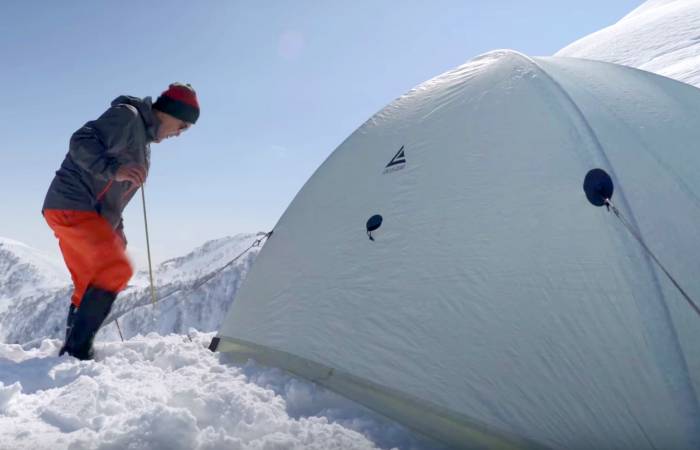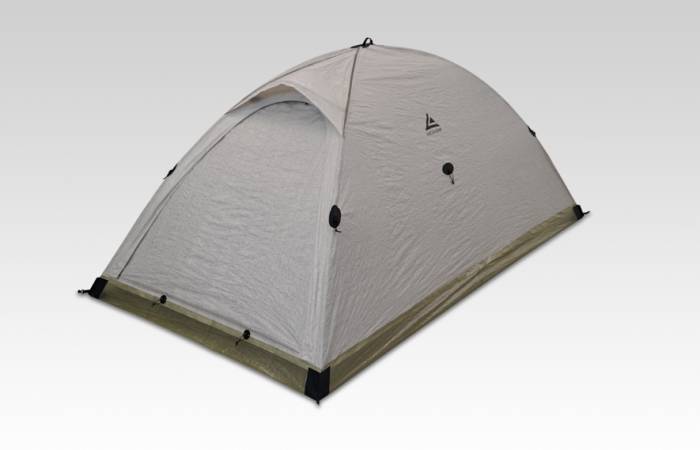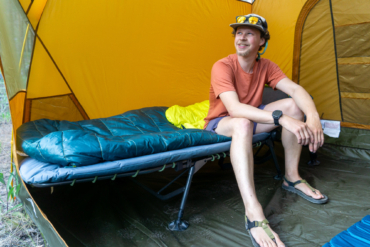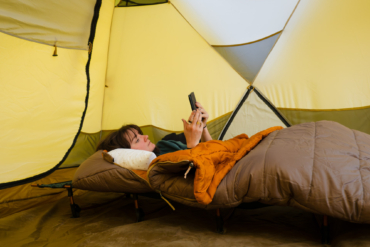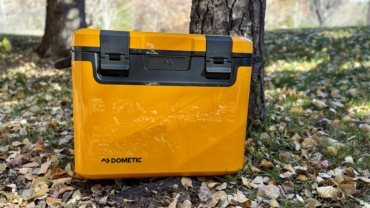A cottage manufacturer out of Japan just launched a single-wall dome tent that weighs under 2 pounds and can face the challenges of alpine climbing and mountaineering. The brand’s secret is in its material: Dyneema fabric.
Dyneema Composite Fabrics exhibit remarkable strength for their weight. Renowned cottage manufacturers like Hyperlite Mountain Gear and Z-Packs use these fabrics to push the limits of lightweight design.
Now, a Japanese tent company called Locus Gear introduces a tent that combines the strength of Dyneema fiber with the waterproof-breathable properties of eVent microporous membrane.

The result is a tent that weighs less than 2 pounds and can withstand gale-force winds.
Locus Gear Djedi Tent
Jotaro Yoshida, the founder and designer of Locus Gear, worked for four years to develop one of the first commercially available dome tents made from a waterproof-breathable Dyneema Composite Fabric. He named it the Djedi.
Check out the video below detailing his quest to build the perfect ultralight tent.
Single-Wall Breathable Tent
Unlike many tents, the Djedi has only one wall between the user and the elements. This single-wall design requires a breathable membrane to allow moisture to escape.
GearJunkie spoke with DSM Dyneema reps Wes Hatcher, applications manager, and Keith McDaniels, product coordinator, to learn more about the fabric.
“It’s one of the lightest waterproof-breathable materials out there,” Hatcher said. “This tent is just a little larger than a Nalgene bottle when packed.”
Indeed, the Djedi is small and light. Without its optional front mesh panel, the total tent weighs just 1.94 pounds. That includes a stuff sack and carbon fiber poles. With a mesh panel for insects, the package tips the scales at 2.16 pounds.
Unlike a lot of other ultralight tents, Hatcher points out that this type is also intended for use in high alpine environments, where high winds and snow are likely.
Dyneema Composite Fabric Properties
The fabric, a marriage between stronger-than-steel fibers and waterproof-breathable eVent, has a tensile strength of 54 pounds per inch.
The stretch at its breaking point is approximately 3 percent, whereas silnylon elongates about 30 percent when dry. What that means is that, even when wet, the material has very little stretch.
For a tent, that means it does not sag. It also means that manufacturing has to be perfect because it won’t stretch to accommodate poles if the size is a little wrong.
The final product proves very breathable. In the lab, the water vapor transmission rate was measured at 50,000 grams per square meter per 24 hours. It’s waterproof enough to resist a 15,000-mm water column. These are high standards in outdoors manufacturing and would be presented as 15K/50K waterproof-breathability on products like apparel.
“Dyneema Composite Fabrics absorb very little water compared to traditional tent fabrics,” McDaniels said. “There aren’t many single-wall tent materials on the market, so it’s difficult to make a comparison on [strength], since it also depends on the weight/denier of the particular silnylon. I think in this case we are equivalent in strength, but the fabric weighs significantly less.”
Djedi Ultralight Tent
The Djedi is clearly a super niche product with limited production. Made by hand in Tokyo – one at a time – the tent retails for a whopping $1,175.
The fabrics are a big piece of the puzzle. They weigh just 40 grams per square meter, which is very low for their properties. The Dyneema Composite Fabric allows for fully bonded manufacturing instead of stitching at seams. This results in a stronger tent that does not require seam sealing.
“Bonding gives you a much stronger package at much lower weight,” Hatcher said.
In all, the Djedi provides a proof of concept to show what is possible within the world of tent design. By using innovative fabrics and manufacturing techniques, the tent pushes the limits of what manufacturers can do.
Dyneema From the USA
Dyneema Composite Fabrics are made in Mesa, Arizona. The Dyneema fiber, in this case, comes from Greenville, N.C. It’s one of few high-tech, American-made fabrics that manufacturers worldwide highly covet.
“We do work with a lot of U.S. brands as well,” Hatcher said. “We wanted to make this topic, this subject, more global. You have this cottage industry in Japan doing absolutely amazing things with our fabric.”
Don’t be surprised to see this technology seeping into more mainstream products soon.
“We are making strides to get our materials into more mainstream tents and products,” Hatcher said. “We’ve had some recent interest by other outdoor brands who are starting to take a closer look at the materials in their collections.”
Keep your eyes open for pack-lightening technology from DSM Dyneema. The brand is already well known among U.S. cottage manufacturers for strong, lightweight fabric that stands up to the toughest environments on Earth.
This post is sponsored by Dyneema. Learn more about this fabric here.

